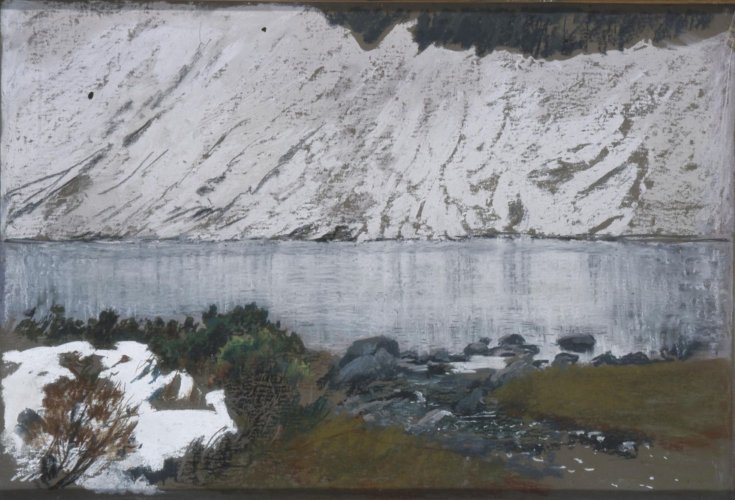Description:
Leon Wyczółkowski (1852-1936) often visited Ukraine since the 1880s. He visited Berezna at Kazimierz Podhorski‘s, his brother Michał, and his sons Władysław and Stefan*. Years later, he remembered, “I left at night and couldn‘t get enough by morning. I couldn‘t be indifferent to the beauty of nature. The most beautiful country. […] Apiaries […] with dozens of hives […] a river flowing, a delightful spring, countless reeds with wicker, fishermen twirling, flowering trees, a southern sky, navy blue and ultramarine, and in the background, flowers. Colorful people, noblemen, ribbons, wonderful scenes like in a fairytale. No wonder I couldn‘t get used to anything else afterwards.”**.
Description of the painting:
Leon Wyczółkowski transports us to the Tatras mountain range with his landscape, a place where a close relationship developed between the founder of Rogalin Gallery – Edward Aleksander Raczyński, and his future wife Róża from Potocki Krasińska family. After the death of her first husband Władysław, Róża moved with her three children, all of them suffering from tuberculosis, to the Zakopane house purchased from the forest master Gustaw Finger. She hoped that the mountain air would be beneficial for their health. The house was inhabited by them from 1877 to 1889 and was named after her son “Adasiówka”, thus becoming a cultural center at the same time. In 1884, the widower Edward Aleksander and his six–year–old son Karol found their way there. Two years later they decided to get married and their offspring were Roger Adam and his younger brother Edward Bernard, born in Zakopane. The first one was the last pre–war owner of Rogalin and the Ambassador of Poland in Romania, and the second one was an avid skier, President of Poland in exile and the last male descendant of the Rogalin line of the family.
Perhaps, in addition to appreciating the artist‘s talent, the purchase of several of Wyczółkowski‘s Tatra works was prompted by memories and a love of mountain landscapes. The discussed painting most likely depicts Czarny Staw, which borders Morskie Oko, one of the artist‘s favorite Tatra subjects. A sandy path leads us to the edge of the lake, covered with stones at the edge of the water. On both sides of this path, vegetation appears in different shades of green and brown, showing the transience of nature, taking on ruddy colors after winter frosts. They mark their trace with a white layer of snow, covering a fragment of the land on the left side of the composition. Against this background, a slender shape of a bush with withered leaves appears, accompanied by a strip of evergreen fir, surrounding a cluster of snow. Above them, in the central field of the painting, a horizontal strip of water stretches to both edges of the canvas. In the lake‘s surface, a view of the surrounding rocks can be seen, hidden under a layer of white fluff. Their highlighted uneven, rough texture provides a contrast to the flat surface of the water, in which their mirror, distorted reflection is recorded. In the other, warmer times of the year, the almost black color of the lake now gains a new bright dress, whose color is opposed by the higher parts of the peaks, visible in the upper right corner of the work. Their color harmonizes with the rocks of the foreground.
The work, done in the pastel technique, is dominated by line and color with its delicate and luminous tones. Echoes of Syntheism of flat spots, Japanese linearism or Impressionistic luminosity, stopping on the surface of the water with small, white and silver pigments can also be seen. This small piece of landscape shows a peaceful and calm scenery of a sleeping mountain element, with which Wyczółkowski came into contact for the first time in 1896 and remained enchanted until 1926. In most of his Tatra works, the artist used pastels that allowed him to quickly register the current lighting and mood. The issue of allergy to oil paints, which Wyspiański also suffered from, also came into play. Wyczółkowski also used other techniques in his work: watercolor, graphics, ink, chalk, looking for the best expression of his artistic craft.
In 1869, Leon Wyczółkowski began his studies in the Drawing Class in Warsaw, choosing the studios of Aleksander Kamiński, Rafał Hadziewicz, and Wojciech Gerson. He then studied for two years at the Academy of Munich with Alexander Wagner. After returning to Poland in 1877, he became a student of Jan Matejko at the School of Fine Arts in Kraków, where from 1895 to 1901 he ran his own painting studio. He was one of the founding members of the Polish Artists‘ Society “Sztuka”, and was involved in the activities of the Vienna “Secession” and the Czech Academy of Sciences and Fine Arts. Seven of his works are currently on display at the Rogaliński Gallery, while nine are considered lost.


